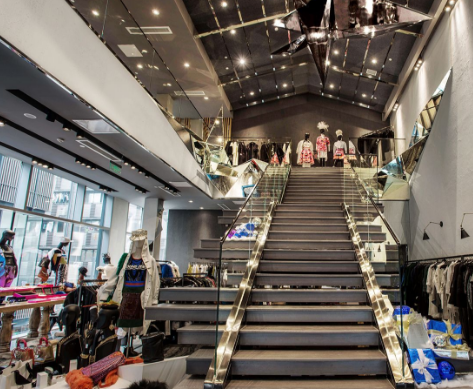French National Institute Of Circular Economy: Textile Recycling Begins At The Design End.
The The French National Institute for the Circular Economy/INEC released a report recently that the textile recycling technology still has technical constraints.
INEC has assessed the current economic cycle of the textile and garment industry, pointed out the limitations of textile recycling, and stressed the need to predict the availability of recycled materials from the initial design stage.

The report shows, according to the category:
Cotton fabric recycling technology has been quite mature, but the quality of regenerated fiber is inferior to that of raw fiber, resulting in new garments.
Regenerated fiber
The utilization rate can only reach 20%; wool can be reused many times; polyester polymers can be reconverted into new fibers.
The situation of polyester fiber is very special. The main component of recycled polyester fiber clothing is plastic bottle.
On the whole,
Textile and garment industry
The biggest challenge lies in the recovery and reuse of blended fabrics. The difficulty of recycling is to separate many different fibers.
Blended fabrics are mostly used for fast fashion brands.
INEC pointed out that the use of sustainable development fabrics at the beginning is a good choice, such as the use of biological cotton, Searl fiber (Eucalyptus cellulose), flax and other more environment-friendly fibers, instead of ordinary cotton, rayon and other fibers.
On the other hand,
Textile and garment industry
New methods should be adopted from the source of production.
"We must invest heavily in R & D and recycling technology so that recycled materials can have the same value as new materials.
The choice of design can greatly reduce the environmental impact of clothing, while improving circulation. "
At present, every production of a garment will leave 20 to 30% of leftover material, which can be optimized through material selection.
In the denim industry, for example, only 30% of a pair of jeans can be recycled by means of stitching and rivet design elements.
If only a single fabric is used, the whole recovery process can be simpler.
In addition, environmental destruction of dyes should not be neglected.
With the same concept of "Greenpeace" in the international environmental protection organization, INEC believes that reducing the use of toxic chemicals is a prerequisite for the realization of circular economy in the textile and garment industry.
Textile is being realized.
clothing
In the process of industry recycling, producers are not the only participants, consumers must contribute.
Since 2000, the number of clothing purchased by consumers has increased significantly, and the service life of clothing has also been shrinking.
In 2015, there were 6 million 400 thousand tons of clothing in the European market.
Every year, the French market adds an average of 9.5 kilograms of clothing, home textiles and
Shoe shoe
Products.
In 2017, France's potential recycling capacity was 36% of market circulation, that is to say, nearly 80% of Europe's fabrics would not be recycled.
In addition to appealing to consumers' rational consumption, INEC believes that alternative services such as customized services, clothing production and upgrading can also be considered.
"These downstream marketing strategies can connect terminal customers to participate in designing products that meet their personal preferences and satisfy their personal needs, and also enhance brand loyalty. On the other hand, it also improves the life cycle of clothing."
- Related reading

Technology Empowerment Goes Through The Development Of Industrial Textiles.
|
Is The Exhibition Hall Or A Store? Is The Brand Collection Shop A Good Business In China?
|
Will The Decline In Global Clothing Usage Become A New Trend?
|- Clothing direct selling | Fashion China &Nbsp; 20110608_02
- Clothing direct selling | Fashion China &Nbsp; 20110608_01
- Clothing direct selling | Fashion China &Nbsp; 20110607_02
- Global Perspective | India Textile Workers Are Pferred To Other Industries Due To Low Wages.
- Clothing direct selling | Fashion China &Nbsp; 20110607_01
- Clothing direct selling | Dumping &Nbsp Of All Creatures; Wang Likun _02
- Web page | Dressing Skills: Popular Stripes This Summer
- Clothing direct selling | Dumping &Nbsp Of All Creatures; Wang Likun _01
- Clothing direct selling | Fashion China &Nbsp; 20110605&Nbsp; Red Night _02
- Industry Overview | Demand For Advanced Technicians Will Increase In China'S Garment Industry
- Signing Huang Jingyu, Opening The First Full Store, FILA China Multi Brand Matrix First Appeared
- Electricity Supplier Layout Results Show That Foot Locker Rebound In Stock Prices Rose 15%
- Dry Goods: Why Is Compact Spinning Most Suitable For Weaving?
- National Textile Industry Pfer Demonstration Park: The Rise Of Textile And Garment Industry In Korla Economic And Technological Development Zone
- Warm, Thin, Fashionable Gowns Make You The Brightest Fashion Icon In The Crowd.
- "Textile Quality Management Innovation Award 2018" Released A Number Of Quanzhou Clothing And Textile Enterprises List
- All Dull And Twisted Memory Fabric Has Become The New Favorite Of Domestic And Foreign Merchants.
- The Slowdown In Commodity Prices And Cotton Market Prices Both Slowed Down In The Near Future.
- Chinese And French Cutting-Edge Designers Jointly Released The Show: "Meets The Shang" Is Competent And Elegant.
- 2018 China Textile And Apparel Supply Chain Forum Held In Humen To Explore Multi-Dimensional Fashion Industry


















